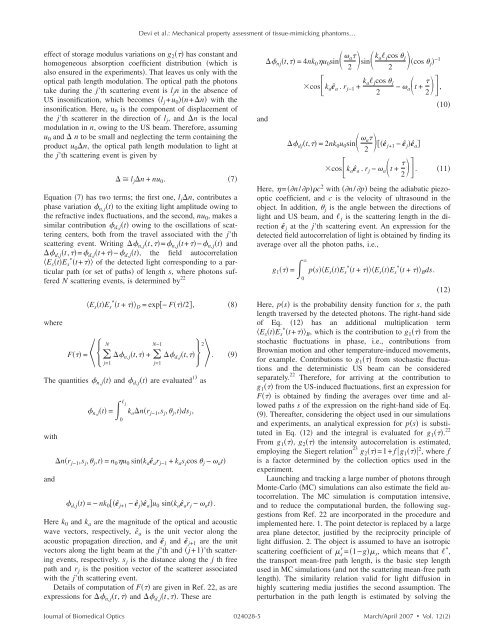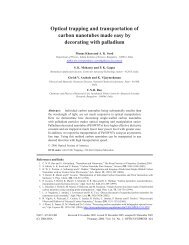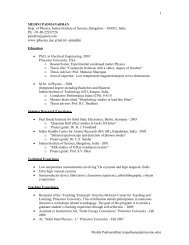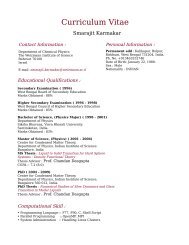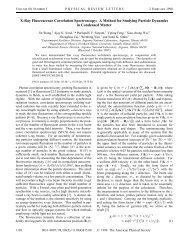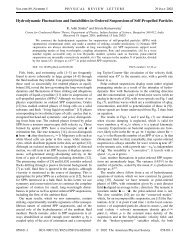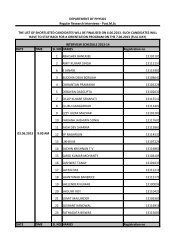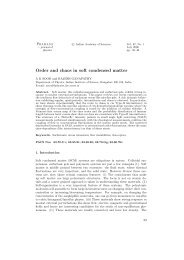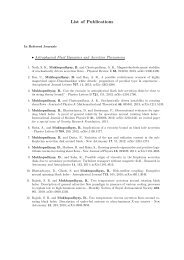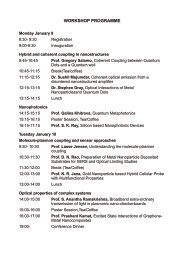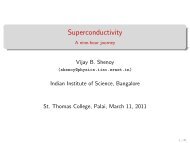C. Usha Devi, R. S. Bharat Chandran, R. M. Vasu and A.K. ... - Physics
C. Usha Devi, R. S. Bharat Chandran, R. M. Vasu and A.K. ... - Physics
C. Usha Devi, R. S. Bharat Chandran, R. M. Vasu and A.K. ... - Physics
Create successful ePaper yourself
Turn your PDF publications into a flip-book with our unique Google optimized e-Paper software.
<strong>Devi</strong> et al.: Mechanical property assessment of tissue-mimicking phantoms…<br />
effect of storage modulus variations on g 2 has constant <strong>and</strong><br />
homogeneous absorption coefficient distribution which is<br />
also ensured in the experiments. That leaves us only with the<br />
optical path length modulation. The optical path the photons<br />
take during the j’th scattering event is l j n in the absence of<br />
US insonification, which becomes l j +u 0 n+n with the<br />
insonification. Here, u 0 is the component of displacement of<br />
the j’th scatterer in the direction of l j , <strong>and</strong> n is the local<br />
modulation in n, owing to the US beam. Therefore, assuming<br />
u 0 <strong>and</strong> n to be small <strong>and</strong> neglecting the term containing the<br />
product u 0 n, the optical path length modulation to light at<br />
the j’th scattering event is given by<br />
l j n + nu 0 .<br />
Equation 7 has two terms; the first one, l j n, contributes a<br />
phase variation n,j t to the exiting light amplitude owing to<br />
the refractive index fluctuations, <strong>and</strong> the second, nu 0 , makes a<br />
similar contribution d,j t owing to the oscillations of scattering<br />
centers, both from the travel associated with the j’th<br />
scattering event. Writing n,j t,= n,j t+− n,j t <strong>and</strong><br />
d,j t,= d,j t+− d,j t, the field autocorrelation<br />
E s tE s * t+ of the detected light corresponding to a particular<br />
path or set of paths of length s, where photons suffered<br />
N scattering events, is determined by 22<br />
where<br />
E s tE s * t + D = exp− F/2,<br />
N<br />
F =<br />
j=1<br />
N−1<br />
n,j t, + d,j t,2.<br />
j=1<br />
The quantities n,j t <strong>and</strong> d,j t are evaluated 13 as<br />
with<br />
<strong>and</strong><br />
n,j t =0 j<br />
k o nr j−1 ,s j , j ,tds j ,<br />
nr j−1 ,s j , j ,t = n 0 u 0 sink a ê a r j−1 + k a s j cos j − a t<br />
d,j t =−nk 0 ê j+1 − ê j ê a u 0 sink a ê a r j − a t.<br />
Here k 0 <strong>and</strong> k a are the magnitude of the optical <strong>and</strong> acoustic<br />
wave vectors, respectively, ê a is the unit vector along the<br />
acoustic propagation direction, <strong>and</strong> ê j <strong>and</strong> ê j+1 are the unit<br />
vectors along the light beam at the j’th <strong>and</strong> j+1’th scattering<br />
events, respectively. s j is the distance along the j th free<br />
path <strong>and</strong> r j is the position vector of the scatterer associated<br />
with the j’th scattering event.<br />
Details of computation of F are given in Ref. 22, as are<br />
expressions for n,j t, <strong>and</strong> d,j t,. These are<br />
7<br />
8<br />
9<br />
<strong>and</strong><br />
nj t, =4nk 0 u 0 sin a<br />
2<br />
sin k a j cos j<br />
2<br />
cos j −1<br />
cosk a ê a . r j−1 + k a j cos j<br />
2<br />
− at + 2,<br />
dj t, =2nk 0 u 0 sin a<br />
2<br />
ê j+1 − ê j ê a <br />
cosk a ê a . r j − at + 2.<br />
10<br />
11<br />
Here, =n/pc 2 with n/p being the adiabatic piezooptic<br />
coefficient, <strong>and</strong> c is the velocity of ultrasound in the<br />
object. In addition, j is the angle between the directions of<br />
light <strong>and</strong> US beam, <strong>and</strong> j is the scattering length in the direction<br />
ê j at the j’th scattering event. An expression for the<br />
detected field autocorrelation of light is obtained by finding its<br />
average over all the photon paths, i.e.,<br />
g 1 =0<br />
<br />
psE s tE s * t + E s tE s * t + B ds.<br />
12<br />
Here, ps is the probability density function for s, the path<br />
length traversed by the detected photons. The right-h<strong>and</strong> side<br />
of Eq. 12 has an additional multiplication term<br />
E s tE * s t+ B , which is the contribution to g 1 from the<br />
stochastic fluctuations in phase, i.e., contributions from<br />
Brownian motion <strong>and</strong> other temperature-induced movements,<br />
for example. Contributions to g 1 from stochastic fluctuations<br />
<strong>and</strong> the deterministic US beam can be considered<br />
separately. 22 Therefore, for arriving at the contribution to<br />
g 1 from the US-induced fluctuations, first an expression for<br />
F is obtained by finding the averages over time <strong>and</strong> allowed<br />
paths s of the expression on the right-h<strong>and</strong> side of Eq.<br />
9. Thereafter, considering the object used in our simulations<br />
<strong>and</strong> experiments, an analytical expression for ps is substituted<br />
in Eq. 12 <strong>and</strong> the integral is evaluated for g 1 . 22<br />
From g 1 , g 2 the intensity autocorrelation is estimated,<br />
employing the Siegert relation 23 g 2 =1+f g 1 2 , where f<br />
is a factor determined by the collection optics used in the<br />
experiment.<br />
Launching <strong>and</strong> tracking a large number of photons through<br />
Monte-Carlo MC simulations can also estimate the field autocorrelation.<br />
The MC simulation is computation intensive,<br />
<strong>and</strong> to reduce the computational burden, the following suggestions<br />
from Ref. 22 are incorporated in the procedure <strong>and</strong><br />
implemented here. 1. The point detector is replaced by a large<br />
area plane detector, justified by the reciprocity principle of<br />
light diffusion. 2. The object is assumed to have an isotropic<br />
scattering coefficient of s =1−g s , which means that * ,<br />
the transport mean-free path length, is the basic step length<br />
used in MC simulations <strong>and</strong> not the scattering mean-free path<br />
length. The similarity relation valid for light diffusion in<br />
highly scattering media justifies the second assumption. The<br />
perturbation in the path length is estimated by solving the<br />
Journal of Biomedical Optics 024028-5<br />
March/April 2007 Vol. 122


